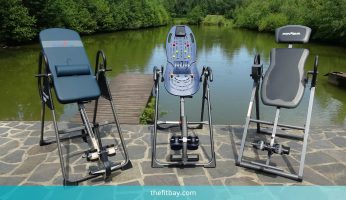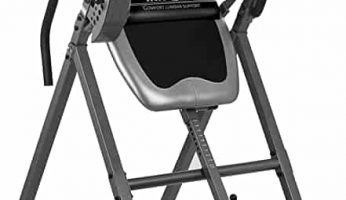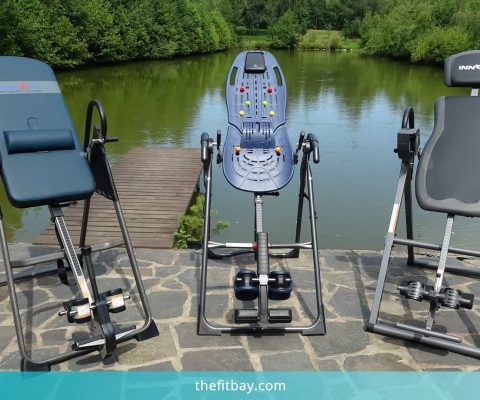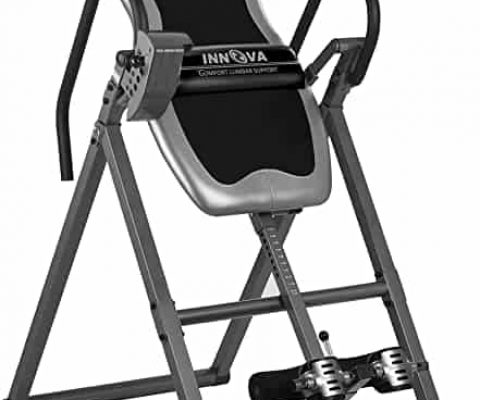Complete Guide to Inversion Tables: Here’s Everything You Need to Know
Disclosure: We use affiliate links and may receive a small commission on purchases.
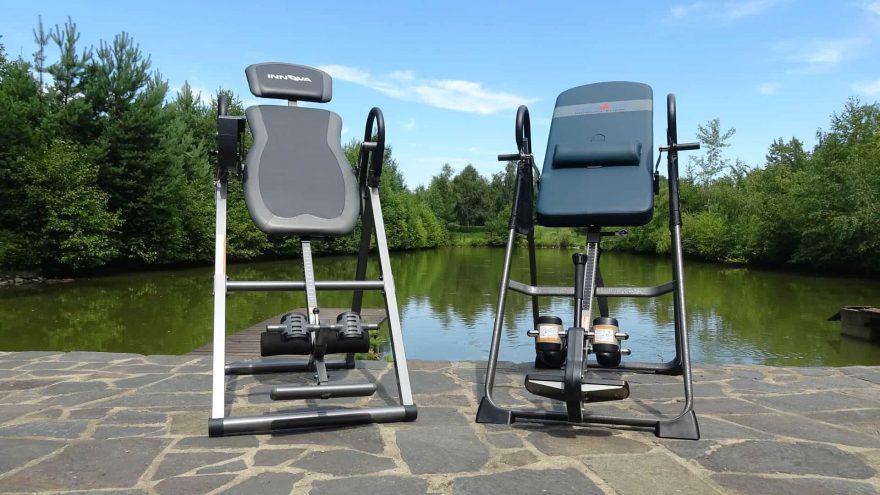 Complete Guide to Inversion Tables: Here’s Everything You Need to Know
thefitbay.com
Complete Guide to Inversion Tables: Here’s Everything You Need to Know
thefitbay.com
If you are looking for in-depth inversion table reviews, be sure to check out our special article about the best inversion tables.
Have you ever heard of the saying keep your friends close and your enemies closer? Well, for most people riddled with back pain, sciatica, poor circulation, and similar health problems, the downward force of gravity is that enemy. Though invisible, you can very much feel the cumulative effects it leaves on your spine and body.
But what would happen if you were to turn this compressive force to your advantage? If you could befriend gravity? To this end, inversion tables can help.
Inversion tables have been used for as long as civilization has existed. In fact, the Father of Medicine, Hippocrates, has lifted his patients up through a pulley and made use of the gravitational force in the far year of 400 BC. (1) His methods paved the way for the emergence of more sophisticated inversion tools, including the modern inversion tables we have today.
This comprehensive guide is packed with everything you need to know about inversion tables. Let’s have a closer look at these fascinating devices.
What Is an Inversion Table?
Simply put, an inversion table is a tool that lets you place your body in an upside down position. They typically consist of a rotational flat board for lying down, handles for you to grip on, a sturdy frame for stability, and ankle holders which secure you safely in place.
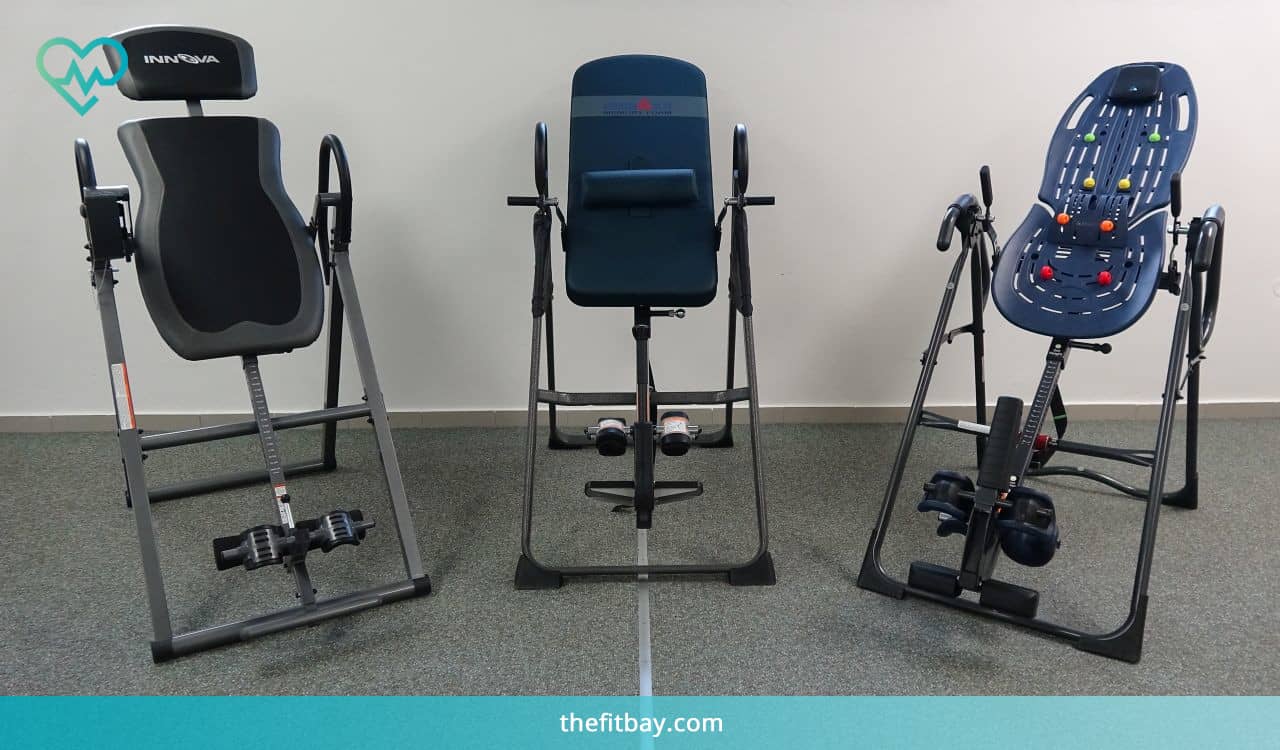
Being by far the most popular tools of this purpose out there, inversion tables come in a myriad of design styles, materials, and finishes.
Depending on your preferences, you’re able to choose between two operational types inversion tables come in – manual and motorized. You may have seen a motorized inversion table during your last chiropractor visit. We’ll mostly talk about the former kind as they provide users with complete movement control and are generally less expensive.
A vast majority of these will feature a sturdy yet lightweight structure, padded upholstery for increased comfort, and a plethora of functions to make inverting from home as simple as possible.
How Does an Inversion Table Work?
Whether you’re sitting or standing, the downward force of gravity pulls you down every single day. This continual compression of your spine, vertebras and discs in turn causes back pain, tingling, muscle weakness, and other symptoms.
And one of the most popular ways of dealing with these conditions that boomed in the late 60s and is still gaining ground today is inversion therapy.
In essence, inversion therapy is a treatment wherein the patient is positioned upside down and uses gravity’s assistance to achieve traction and spinal decompression.
When you hang upside down, your own body weight stretches your spine through the force of traction. (2)
In practice, traction is achieved through either mechanical equipment or gravity itself.
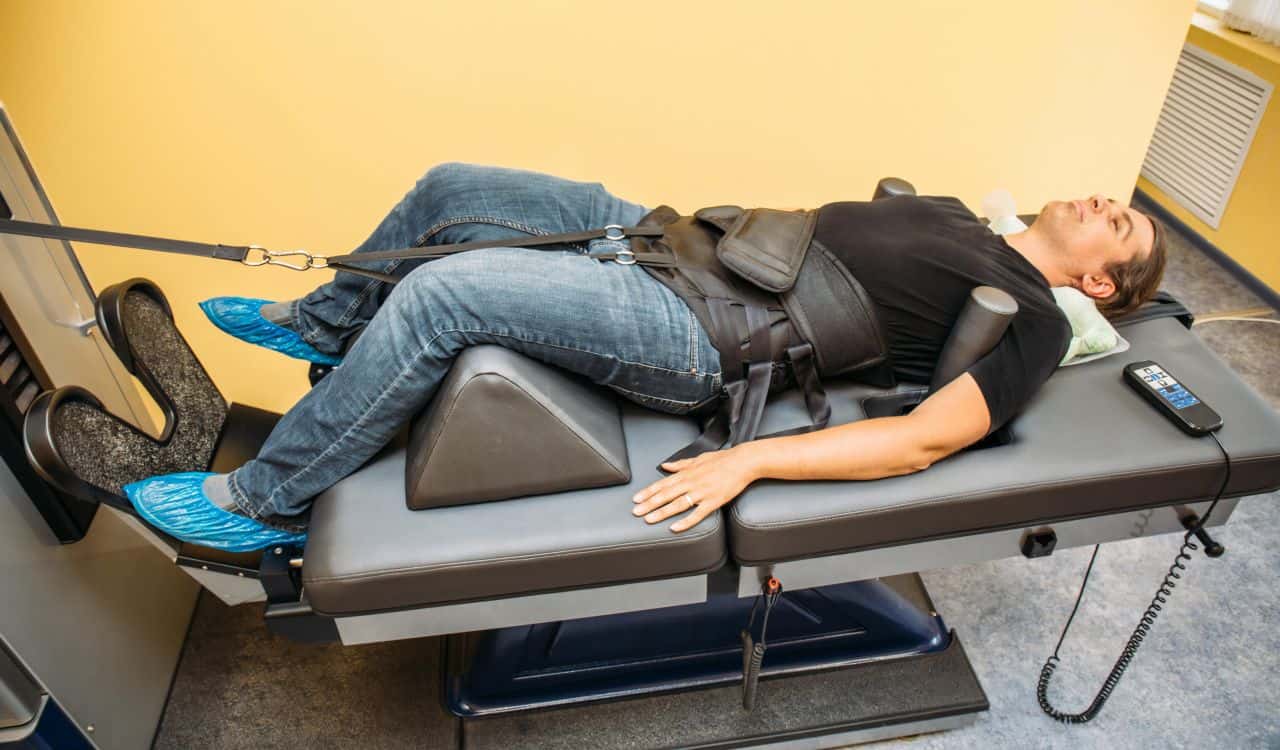
Either way, spinal decompression follows the use of this force and eases pressure of your discs, facet joints, intervertebral foramen, and lumbar musculature.
The decompression of these structures helps ease pain and subsequently improves mobility, strength, and activity tolerance. Several studies support the use of inversion therapy as an effective form of symptom relief in patients with back pain. (e.g. 3, 4, 5)
Naturally, inversion tools have flooded the market as inversion therapy became more and more accepted among the medical community. From gravity boots to yoga swings, the choice is almost endless. However, one product that stands out for its simplicity of use of traction, affordability, and effectiveness is an inversion table.
An inversion table helps you hang upside down freely and reverses the negative effects of gravity by using its force to your advantage. In such a position, your spine decompresses, leading to back pain relief, reduced disc pressure, and even spinal realignment.
Most benefits of using an inversion table, such as reduced muscle tension, occur at 20 degrees, but for a full impact, you should aim to reach a 60-degree angle. This is where your spine stretches and decompresses, relieving you of that nasty back pain.
And inversion tables are by far the most efficient devices when it comes to controlling the extent of traction. They allow you to select a preferred incline angle and choose how far back you want to hang upside down.
Let’s have a look at the numerous studies that show that inversion tables work!
Do Inversion Tables Work?
You may be skeptical about inversion tables and we don’t blame you. After all, we all doubt the unknown.
But now that you’ve learned about the relationship between inversion, traction and spinal decompression, let’s have a look at the top 24 studies backing their effectiveness.
We’ve singled out the most valuable research papers, publications and trials that have put inversion therapy on the map, from its rebirth in the 60s to date.
Let’s dive in.
- 1) In 1964, one of the pioneering studies showed positive effects of inversion therapy on 175 patients who had resigned from their workplaces due to chronic lower back pain. Apart from chronic back pain, some of them suffered from sciatica, herniated and bulging discs, or spondylolisthesis. The trial subjects were given 8 sessions of inversion therapy, and 155 of them managed to return to full-time work, as they experienced zero to insignificant back pain after the treatments.The 1964 study emphasizes the effect of stretching the ligaments and possibly allowing the intervertebral discs to decompress. Decompressing the tensed discs helped in returning them to their original position.
Source: Sheffield F.; Adaptation of Tilt Table for Lumbar Traction. Arch Phys Med Rehabil 45. 1964 - 2) Another study whose subjects were employees was the Volvo Aero Corporation Study done by Dr. Dimberg. It examined the effects of inversion therapy on the chronic lower back pain of company workers. The study took twelve months and included 116 people from 3 groups. Scientists showed a decrease in the number of sick days concerning back pain by 33% and also a decrease in overall sick days by 7.9 % per person. In conclusion, inversion therapy is a cost-effective and simple way to improve workers’ health and thus lower employers’ expenses due to workers suffering from chronic lower back pain. (6)
- 3) A study was also done focusing on internal disc pressure in the third lumbar space – the Nachemson study. The measurement was done in various conditions – when lying, sitting, standing, and bending, along with supine and vertical traction. While testing, it was revealed that the pressure inside the disk of a lying body is equal to 25% of the pressure when standing. It also proved that a 25% decrease of inner disc pressure will be reached when the body is exposed to a traction equivalent to 60% body weight. This traction can happen in an inverted position when lying at a 60° angle or higher. The results prove the eventuality of lower back pain relief in inverted positions.
Source: Nachemson A. and Elfstrom G.; Intravital Dynamic Pressure Measurements in Lumbar Discs. Scandinavian Journal of Rehab Medicine. 1970 - 4) In 1978, scientists began researching the effect of spinal traction (which is similar to how inversion therapy works) and found that pressure on the discs and muscle tension decreases by 35% after spending a mere 10 seconds using the equipment. They also concluded that between chairs and tables for inversion therapy, the latter seemed to be more effective.Now, to the ultimate question, “Were the inversion therapy effects permanent?” The statistical results have shown that EMG activity (which indicates pressured intervertebral discs) is decreased upon returning to the original position. As opposed to the opinions of many experts who claim that inversion table results are temporary, no matter how you look at it, this is a permanent result, albeit minor.
Source: Nosse L.; Inverted Spinal Traction. Arch Phys Med Rehabil 59. 1978 Aug - 5) Another study proving the effects of inversion therapy for back pain relief is the Kane study from 1985. Scientists came to the conclusion that using traction equipment that causes intervertebral separation in the lumbar spine based on gravity effectively results in back pain relief.
Source: Kane M., et al.; Effects of Gravity-facilitated Traction on Intervertebral Dimensions of the Lumbar Spine. Journal of Orthopedic and Sports Phys Ther. 1985 Mar - 6) One of the most recent studies was conducted in England and had been published in 2012. Researchers from Newcastle University examined the use of inversion therapy for sciatica treatment and the need of spinal surgery. It was established that “inversion therapy decreased the need for an operation in sciatica due to single level disc protrusion to 23% as compared to 78% in the non-inversion group.” This conclusion leads to one more finding. The study also points out that a reduction in needed surgery leads to important budget savings for health care.
Source: Manjunath Prasad, K. S., Barbara A. Gregson, Gerard Hargreaves, Tiernan Byrnes, P. Winburn, and A. D. Mendelow. “Inversion Therapy in Patients with Pure Single Level Lumbar Discogenic Disease: A Pilot Randomized Trial.” Disability and Rehabilitation 34.17 (2012) - 7) You might be interested in the findings of the Musculoskeletal Science and Practice Journal, which evaluated the effects of traction on intervertebral disc height. The participants in the study had no previous history of low back pain or degenerative disc disorders. The researchers conducted MRI scans on participants during horizontal lying without traction and with horizontal traction at 42% of the participants’ body weights. The imaging was compared at various locations of the intervertebral discs and it was found that there was a significant increase in average disc height and reduction in lumbar lordosis following the application of lumbar traction.These findings may be significant, as an increase in intervertebral disc height may lead to decreased overall pressure on the tissues at and around the lumbar spine. Those with back pain caused by degenerative disorders such as degenerative disc disease or spinal stenosis may benefit from the use of traction to alleviate adverse symptoms. (7)
- 8) The results of a 1985 study conducted by Gianakopoulous et al. observed the effects of two inversion devices and one upright suspension device on the lumbar spine. Through lumbar spine radiographs, increases in intervertebral spaces of up to 4 millimeters were observed with inversion traction. Additionally, 13 out of the 16 participants reported improvements in their low back symptoms following the inversion trials. The study supports the use of inversion therapy devices as a practical method of back pain relief in the home setting. (8)
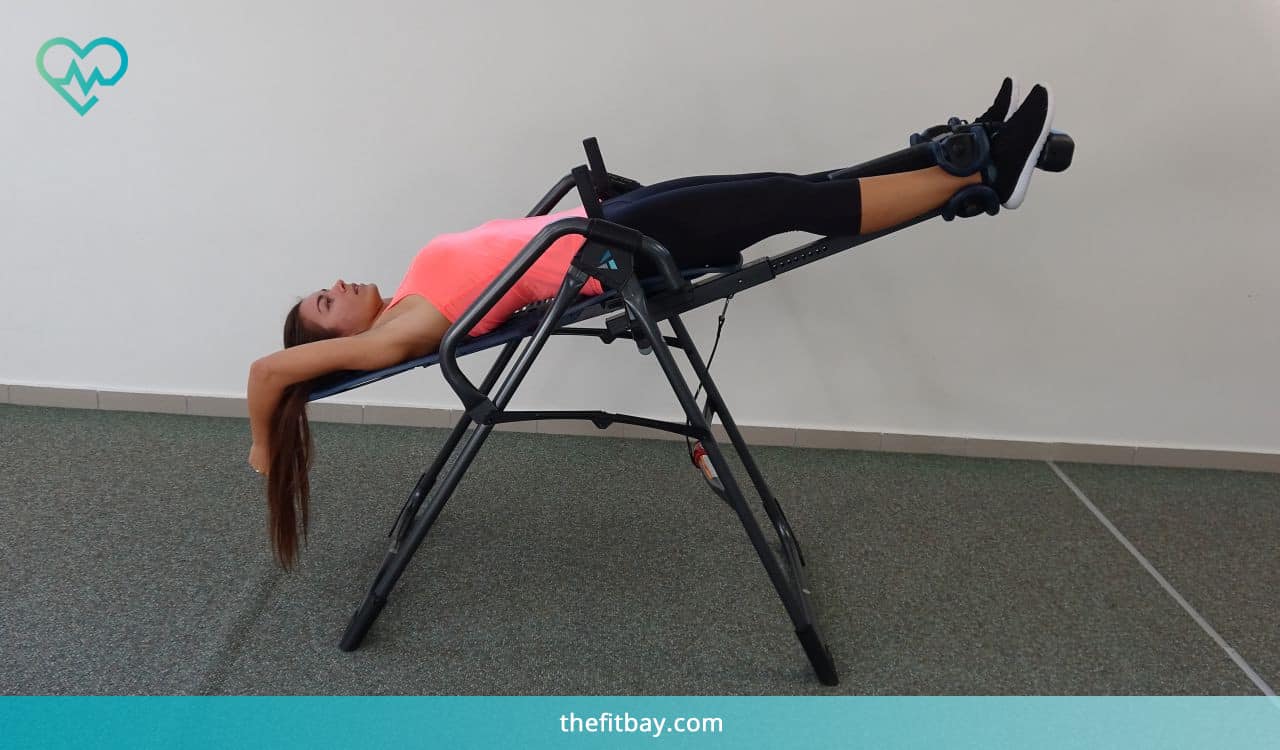
- 9) Matthews et al. assessed treatment interventions for back pain and sciatica. The results supported the use of traction as an effective means to relieve symptoms related to both back pain and sciatica. Both subjective questionnaires and objective measurements improved in the participants who received traction as a therapeutic intervention. (9)
- 10) A 2007 randomized controlled trial observed the effects of mechanical traction on sixty-four participants with low back with sciatica. The participants were divided into two groups, one receiving a 6-week extension-oriented intervention, and the other receiving the same intervention but with concurrent mechanical traction during the first 2 weeks.The group who received mechanical traction showed greater improvements in their subjective reports of disability and fear avoidance behaviors, as well as improvements in their sciatic symptoms with lumbar spine motion. Overall, this study demonstrated that people with sciatic symptoms and nerve root compression may benefit from mechanical traction. (10)
- 11) A large sample group study in 2005 recruited a total of 296 patients with low back pain and evidence of a degenerative and/or herniated disc at one or more lumbar spinal levels. The participants were given five 30-minute traction session per week for 4 weeks, followed by one 30-minute session per week for an additional 4 weeks. Objective pain and disability scores were obtained at the 30 and 180 day marks following discharge.Significant improvements in both outcome measures were noted at both the 30 day and 180 day follow-ups. These results indicate that lumbar traction can be an effective method in reducing symptoms related to low back pain. (11)
- 12) Another study in 1999 examined the effects of interferential therapy compared to motorized traction and massage for management of low back pain. A total of 152 patients were recruited and divided into two groups, each receiving one of the two above mentioned modalities. Objective measurements of disability and pain were similar before beginning the study, and both groups significantly improved their scores in these categories following administration of their respective interventions. There were no significant differences in the amount of improvements between the two groups at the end of treatment. (12)
- 13) In 1985, the Journal of the Canadian Chiropractic Association examined several physiological parameters of the lumbar spine and surrounding structures following inversion traction therapy. The results of the test demonstrated significant increases in lumbar flexion range of motion, a reduction in the hypertonic activity of the surrounding lumbar musculature, and noticeable levels of distraction in the L4-L5 and L5-S1 disc spaces. All of these improved parameters came without significant change in heart rate and blood pressure, indicating that inversion traction therapy may be a safe intervention with for people with back pain. (13)
- 14) This systematic review conducted by the IOSR of Mechanical and Civil Engineering compiled 8 studies on inversion as a treatment for people suffering with back pain with or without sciatica. After examining the results of these eight studies, this review determined that many back problems reduced following the use of inversion.Furthermore, several of the studies examined by this review showed that use of inversion therapy reduces the need for surgical procedures in subjects with back pain or sciatica. This concludes that inversion may be an effective alternative method to treat those with lumbar spine issues. (14)
- 15) A 2013 study evaluated the effects of varying degrees of inversion traction therapy on levels of pain, lumbar flexibility and trunk muscle strength in patients with chronic low back pain. Forty-seven females with nonspecific low back pain with symptom duration of 18-28 weeks were recruited for the study. They were divided into groups receiving traction at either 0 degrees of inversion, 30 degrees of inversion, and 60 degrees of inversion.The group that received traction at 60 degrees of inversion demonstrated significantly lower levels of pain and improved peak trunk muscle strength compared to the other two groups. All three groups showed significant improvements in lumbar flexibility. The results of this study support that traction, particularly in a 60-degree inversion position, may be an effective treatment modality in those with chronic low back pain. (15)
- 16) Another intriguing study published in the Disability and Rehabilitation Journal assessed the response of inversion therapy in patients with lumbar disc disease. The study recruited twenty-four participants who had been listed to undergo surgery to correct their sciatica symptoms. The participants were divided into two groups: one that received a combination of inversion and physiotherapy and the other that received physiotherapy alone.Ten of the thirteen (76.9%) participants in the inversion group ultimately avoided surgery, whereas only two of the eleven (22.2%) participants in the physiotherapy group avoided surgery. This suggests that inversion can be used alongside other forms of therapy to improve outcomes and possibly avoid lumbar surgery. (16)

- 17) An Archive of Physical Rehabilitation Medicine study observed the changes in spinal length and electromyographic (EMG) activity of the lumbar musculature following inversion. The group that received inversion showed significant differences in spinal length and reduced EMG activity of the lumbar spine musculature. This study suggests that changes in spinal length and muscle activity can be achieved with only a short time of inversion. (17)
- 18) A publication from the Advanced Practices in Nursing assessed the benefits of inversion as it relates to fluid flow throughout the body. This publication discusses the improvements of venous return from the lower extremities to the heart when using varying degrees of rhythmic inversion. Because of improved venous flow, blood circulated back to the heart with better efficiency and reduced pressure in the peripheral arteries. Because of this finding, the authors concluded this to be a safer and healthier approach to combat hypertension as opposed to medication. (18)
- 19) A fascinating 2007 study performed by Fritz et al, sought to identify subgroups of patients with low back pain that would benefit from any type of lumbar traction. The sixty-four participants with low back and leg pain with signs of nerve root compression were oriented into two groups: one receiving a 6-week exercise program and the other receiving the same exercise program but coupled with traction for the first 2 weeks.The group receiving traction demonstrated greater improvements in disability and fear avoidance behaviors than the group with exercise alone after the first two-week period. This study was so significant that it prompted the American Physical Therapy Association to change their treatment based classification system to include traction as a subgroup of back pain patients. (19)
- 20) A 2015 study published in the Journal of Orthopedic and Sports Physical Therapy determined that 76.7% of American physical therapists use various forms of traction with patients who present with back pain or signs of nerve root compression (as in sciatica). Their administration of the intervention includes several methods such as manual, mechanical, and inversion traction.This is significant, as the majority of professionals that most often deal with back pain and sciatica utilize traction as a method of pain control and symptom relief in their patients’ plans of care. (20)
- 21) This study examined both the structural and functional effects of traction with patients affected by back pain and sciatica. The patients recruited for the study had sciatic symptoms stemming from a lumbar disc herniation. Although no significant change in the size of the disc herniation was observed, marked clinical improvement in nearly all of the subjects was noted following the administration of traction. (21)
- 22) A case report in 2010 studied the effects of traction combined with exercise on a patient with a L5-S1 disc herniation. The patient experienced back pain with radiating numbness and pain spreading to his leg. The first five sessions of physical therapy consisted of lumbar extension exercises, and the following nine sessions included traction as an adjunct to exercise. Pain levels and functional scores improved dramatically over time, and the patient no longer experienced radiating symptoms following the 14th session. This suggests that traction can be an effective method of relieving symptoms caused by herniated disc when combined with physical exercise. (22)
- 23) A study from the Scandinavian Journal of Rehabilitation Medicine compared the effects of both mechanical and manual traction to bed rest on hospitalized patients with prolapsed lumbar intervertebral discs. The study found that pain intensity in the participants after one week of traction was significantly reduced, and that after a two-year follow-up, there was no recurrence of symptoms. (23)
- 24) A breakthrough study in 1980 investigated the effects of traction as a means of treatment for back pain and sciatica on 82 patients. One group of patients received three one-hour sessions of traction, while the other group was given a brace and advised to rest.The traction group experienced immediate improvements in objective measurements when compared to the non-traction group, and this remained true at the one-week and three-week follow up appointments. This suggests that traction is a much more effective means of treatment compared to rest. (24)
Still in need of convincing? Have a read below to discover some proven benefits of inversion tables.
Benefits of Using an Inversion Table
Us humans have developed quite a sedentary lifestyle. We sit at work, while driving, during social gatherings, and at home – a habit that has inevitably taken a toll on our health; more specifically, on our back and posture.
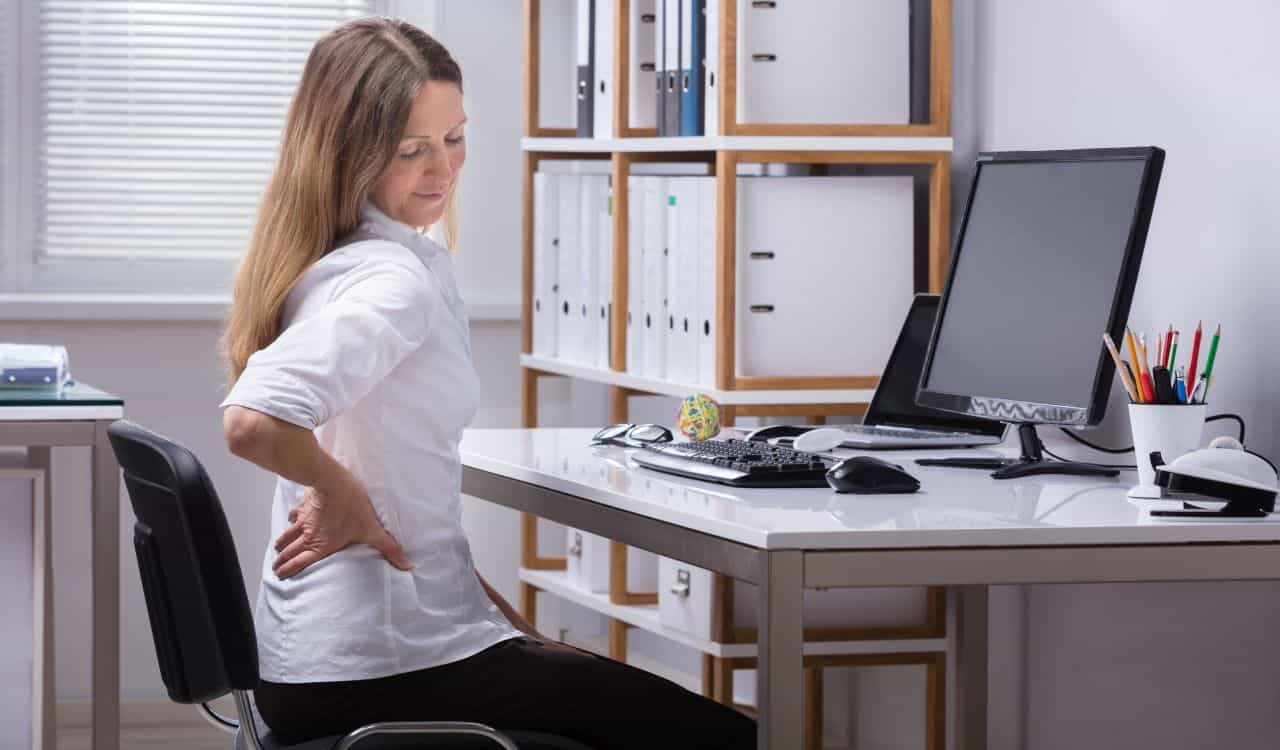
Chances are you’re reading these very words while sitting wrong at your desk, in a chair that hasn’t been ergonomically designed. Your spine is begging for some time out. And inversion tables are among the most popular choices in easing this accumulated nerve pressure and providing a consistent and instant back pain relief.
By stretching and decompressing your spinal column, you benefit from numerous concomitant effects. So what is an inversion table good for? Here are the most prominent benefits:
Back Pain Relief
Inversion tables provide a near-instant back pain relief. Whether the pain is caused by an injury, bulged discs, nerve pressure, or anything in between, using an inversion table has proved time and time again to be an effective and reliable solution. (25, 26, 27)
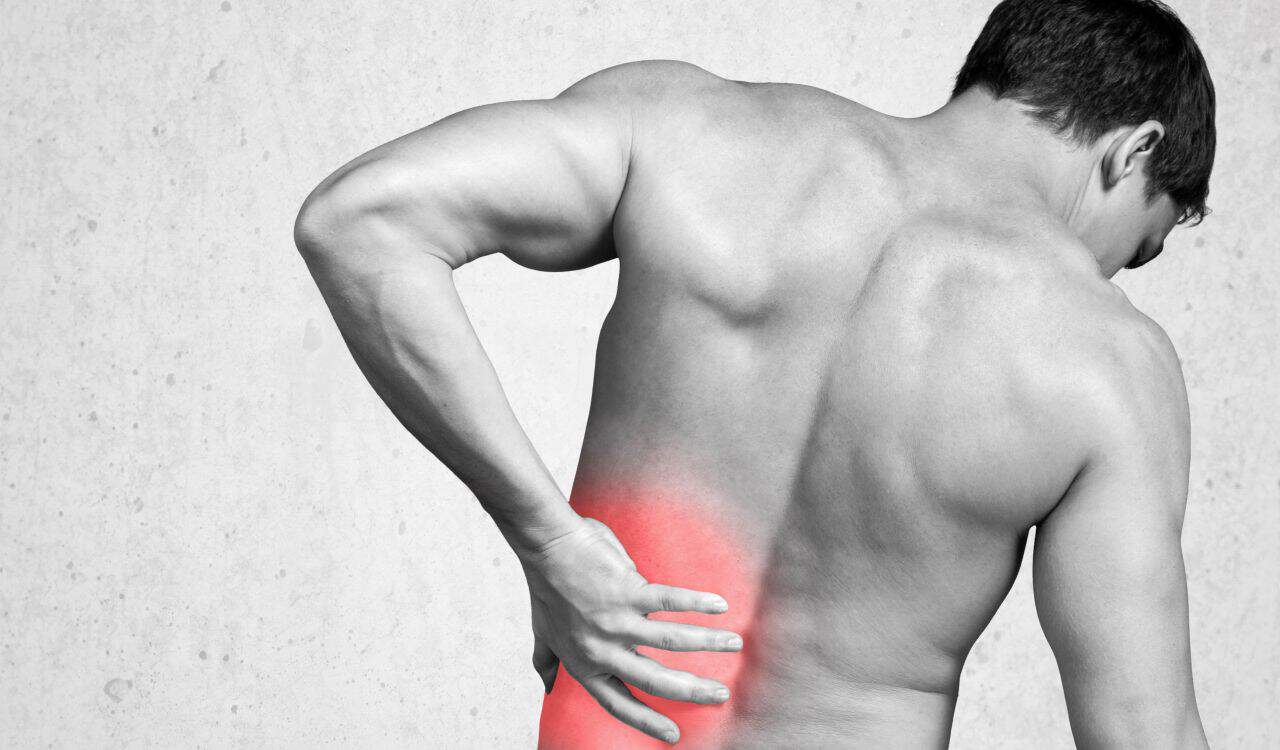
Inversion tables can help relieve back pain by providing a safe and convenient method to decompress the irritated structures. Following the decompression, a relief in pain and improved range of motion may be experienced.
It all boils down to spinal traction and decompression. With a little help from the gravitational force, your spinal cord stretches once your body is an inverted position, creating space between your discs and allowing for a surge in blood flow and nutrients. In turn, your ache disappears along with the pressure that has been taken off. Here’s a video that explains how an inversion table decompresses your spinal cord:
If you’re considering spinal surgery to get rid of your back pain, we highly recommend you first give a shot to all non-invasive therapeutics methods, including the use of an inversion table. A 2012 study revealed 10 out of 13 patients awaiting lumbar disc surgery have avoided it altogether by using an inversion chair for six weeks. (28)
Sciatica & Spinal Stenosis Relief
While sciatica may be caused by compression or tension anywhere along the nerve pathway, oftentimes the source of the issue is at the spine. The spine is compressing the sciatic nerve statically or through movement due to shrunken space between the nerves.
If you’re troubled with stiffness, weakness, numbness, or pain and tingling along the sciatic nerve, inversion tables can help by widening the space between structures that are causing this pressure and by doing so alleviate unpleasant symptoms of sciatica.
Similarly, inversion tables can help provide relief from spinal stenosis by widening the space of the intervertebral foramen and improving pressure on the nerve root. The intervertebral foramen is the space between two articulating vertebrae on either side through which the corresponding nerve root travels.
Related Reading: Do Inversion Tables Help Sciatica?
Narrowing of the intervertebral foramen can cause compression on this nerve root. This may lead to pain, numbness and tingling along this nerve distribution, decreased range of motion, or strength loss within the nerve distribution. By freeing up more space between the vertebrae, inversion tables provide an effective approach in easing the symptoms of spinal stenosis.
Eased Scoliosis Pain
Scoliosis is an abnormal lateral curvature of the spine that can cause an array of problems like pain, stiffness, muscle imbalances, or even abnormal organ development. There are many types of scoliosis, with most being idiopathic. This means that it develops early in life, and the curvature cannot be corrected without bracing or surgery.
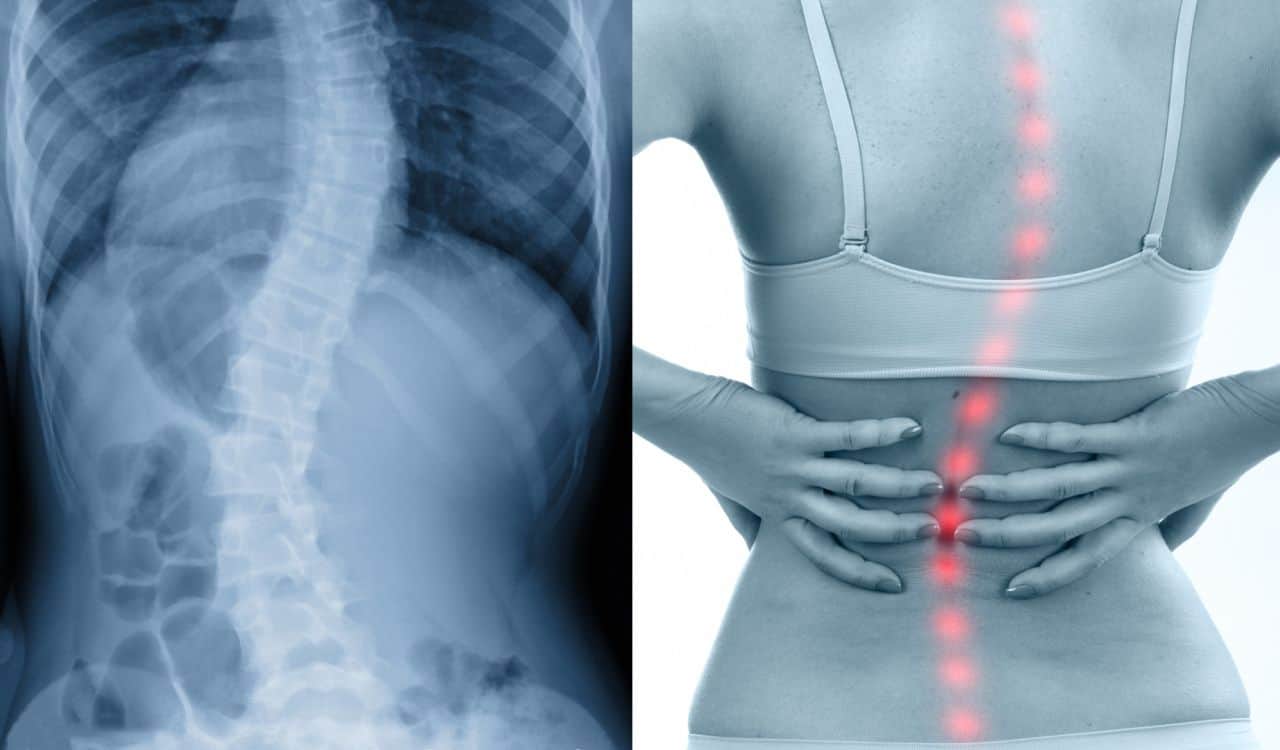
Scoliosis can cause pressure on nerve roots, discs, muscles, and other structures that can cause pain. Although the curvature is likely permanent without intervening with bracing or surgery, many of the symptoms can be treated with inversion tables.
Inversion tables can provide a stretch to the aforementioned structures which can decrease pressure on sensitive areas. The decrease in pressure on the affected areas should lead to a decrease in pain, stiffness, and other symptoms.
Herniated Disc Treatment
Think of your spinal discs as shock absorbers on a car. They’re settled between your vertebrae and are made up of thick fibers on the outside and a gel-like fluid on the inside. The problem with herniated discs is that sometimes this viscous fluid leaks outside of the torn disc into the spinal canal causing pressure on the nerve root between two vertebrae.
Practicing on an inversion table is an effective method of treating disc hernia as the upside down position promotes spinal compression and encourages the disc fluid to flow back into the original position.
Degenerative Disc & Joint Disease Aid
Degenerative disc disease occurs over time when the height of the intervertebral discs decreases. This leads to a smaller space between vertebrae, and may cause pain, limited motion, and increased curvature of the spine. Same goes for your joints – if there’s an increased friction between them, you may suffer from sharp pain, decreased motion, and further wear on the joint.
Although these conditions are degenerative in nature and cannot be reversed without surgical intervention, inversion tables can provide relief by opening spaces between the vertebrae and improving the height of the intervertebral discs.
Improved Posture
Sitting incorrectly 5 days a week for 52 weeks every year will without a doubt leave a negative effect on your spinal column. Poor posture can negatively affect your body and mood in a variety of ways, causing problems ranging from digestive issues to neck and shoulder pain.
Inversion tables provide the necessary traction that allows your spinal cord to decompress and stretch out. Over time, this practice helps your vertebrae move back into correct alignment so that you can achieve and maintain correct posture. (29)
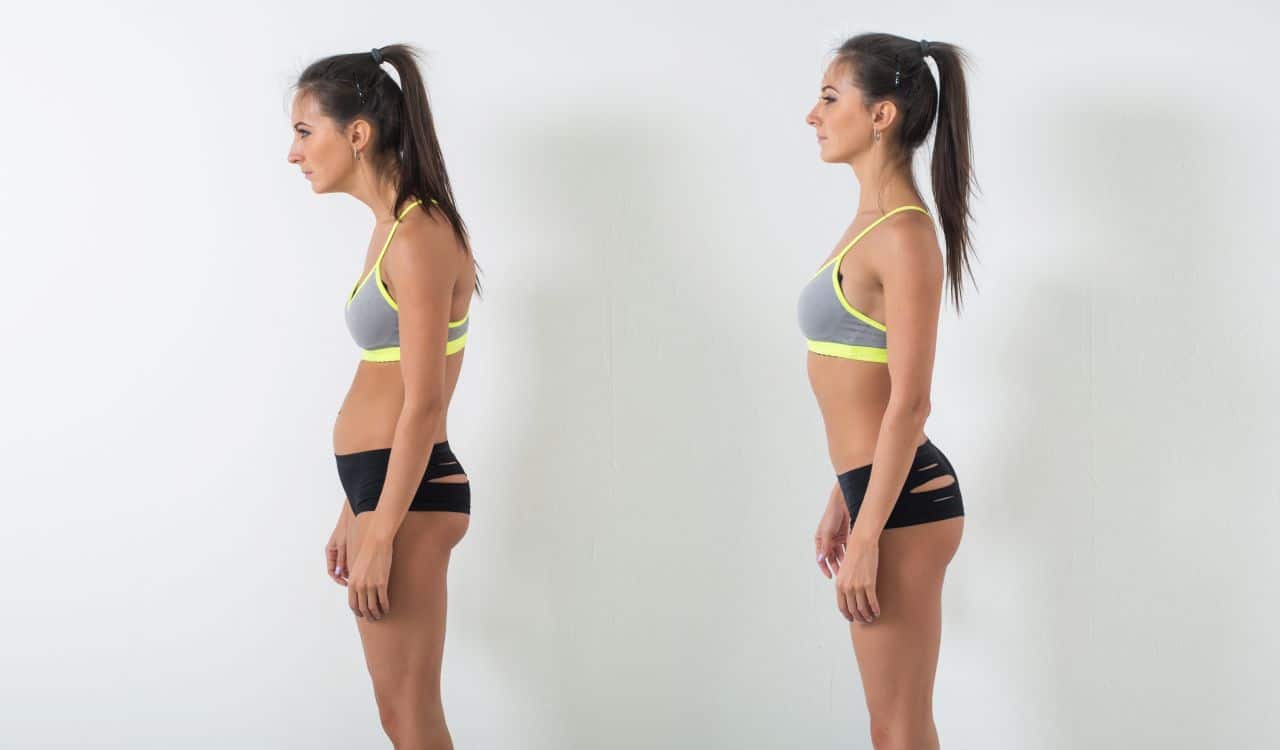
Increased Height
Most people don’t know that regular use of an inversion table can actually make a person taller. As you are probably already aware, our bodies actually shrink a little bit as we go about our daily lives, hence you’re nearly an inch taller in the morning than you are in the evening.
This happens because the pressure in your back fades when you sleep and builds up throughout the day. (30) When you get off an inversion table, you’re likely to immediately feel lighter and taller because of this decompressing effect. Research has found you are likely to gain between 0.2 – 1 inch in height with this method.
Reduced Muscle Tension & Improved Flexibility
Another great benefit of using an inversion table is muscle relaxation. If you suffer from muscle stiffness or a limited range of motion, investing some time on an inversion table can make a world of difference as you’re providing your spine and connected muscles with a low-load stretch. This in turn leads to muscle relaxation resulting in improved motion and flexibility.
In addition, inversion tables can help with cases of the so-called facet syndrome. Facet syndrome is the term for dysfunction or irritation of a facet joint. This irritation can cause pain, radicular symptoms, or decreased motion. Inversion tables can help relieve pressure on these joints and restore motion that has been lost through compressive mechanisms.
It shouldn’t be long before you notice you’re suddenly able to bend further down, have better reflexes, and a much greater range of movement. (31)
Decreased Muscle Spasms & Spinal Curvature
Muscle spasms affect many people who have decreased spinal mobility, or are often a side effect of other sources of back pain. When the body senses threat of injury, it often uses muscles to tighten up and protect the structure in question. However, this tightness can often be unrelenting and cause significant pain.
What’s more, muscle tightness can cause decreased overall flexibility in the spine. Since all muscles attach to a bone, spinal muscles that are tight can pull excessively on vertebrae and cause an increased curvature towards the side of tightness.
Inversion tables can help alleviate muscle spasms by providing a low load stretch to the affected muscles and relieve pressure on structures that may be causing the body to induce muscle spasms as a protective mechanism. Additionally, this low load stretch can decrease the excessive pull of tight muscles on vertebrae and correct the curvature.
Increased Blood Flow & Circulation
Because of the gravitational force, some parts of your body have difficulty in gathering important nutrients and oxygen through the blood. Just a few minutes spent on an inversion table a day can go a long way in increasing your blood flow and improving its circulation to the areas that otherwise wouldn’t be properly supplied.

When you’re in an upside down position, gravity pulls the oxygen-rich blood down to the parts of your body which can make great use of it, including organs of the nervous, lymphatic, endocrine, and cardiovascular system. Inverting like this supports venous return as well, which results in a healthier heart and lower venal pressure. (32)
Enhanced Core Strength & Fitness Level
Those who are looking to support their torso and improve posture through a more challenging way will be glad to hear most inversion tables also allow their users to perform certain exercises which build core strength and tone muscles.
And before you shrug off ab crunches and sit ups as no big deal, remember inverted versions of these need be performed with utmost technical accuracy in order to prevent further back pain and injury. We’ll explain how to do these correctly in a moment.
Risks of Using an Inversion Table
Even though health benefits of an inversion table are copious, there are certain risks that lie with these tools. Hanging upside down isn’t for everybody, as your heart and blood pressure have to adapt to this new position. Your heartbeat drops and your blood pressure increases, meaning inversion tables should be avoided by those suffering from certain conditions, such as:
- Cardiovascular disorders, including stroke, heart disease, and elevated blood pressure
Inversion causes a rise in blood pressure which in turn causes the heart to work harder. It can also cause increased stress on the walls of arteries, veins, and capillaries. This increased workload on the heart and stress on blood vessels can exacerbate the preexisting cardiovascular disorders mentioned above. - Infections and conditions such as glaucoma, pink eye, ear infections, and cerebral sclerosis
Increasing blood pressure from inversion can worsen these conditions caused by increased pressure in the eyes, ears, and brain. In some cases, the rise in pressure can rupture the capillaries in these areas, causing bleeding out of the eyes, ears, or in the brain. (33) - Problems with bones and joints, including osteoporosis, arthritis, disc hernia, and spinal cord injuries
If these conditions are severe enough, the pull inversion creates may be too much stress for these tissues to handle. Stressing weaker tissues may actually increase pain and worsen your symptoms.
The Dangers of Doing it Wrong
In addition to these risks, some people tend to injure themselves by using an inversion table incorrectly. For example, improper fastening of the ankle holders can result in an ankle sprain while rapid dismounting can cause dizziness, lightheadedness, and disorientation. We will explain how to use an inversion table properly without risking any injury or discomfort a bit later on.
Common Mistakes
Some people let the impatience get the best of them and jump head first into using an inversion table without keeping crucial precautions in mind. Here are some of the most common mistakes beginners make when starting out.
- Setting an Intense Inversion Angle
This seems to be a widespread one. Starting with a challenging incline angle increases the changes in blood pressure your body experiences and can result in a range of symptoms from dizziness to headaches. Make sure you allow your body to slowly adapt to this new position by setting a modest inversion angle. - Overdoing it
Another major mistake is staying inverted for too long, expecting better results. People doing this don’t realize they’re needlessly raising their blood pressure and over-stretching their muscles ligaments and tendons. If these tissues cannot cope with the new position for a long time, symptoms could worsen and you run the risk of suffering from headaches and fainting. - Hurting Ankles, Knees, and Hips
Fastening the ankle holders too tight can result in joint pain, including ankles, knees, and hips. Make sure you are securely strapped but leave a little space for comfort.
In short, by allowing yourself to accustom to the practice of inversion, you’ll lower the risk of doing any harm to your body in any way. The best advice anyone can give you is to listen to your body and track the progress you’re making. Only then will you maximize the benefits of inverting.
What About Pregnancy?
Pregnant women know very well how constraining and wrenching back pain can be. After all, carrying a tiny human being around all day puts enormous pressure on the spine and skeletal system. For them, inversion tables may look like a logical solution but are they actually safe?
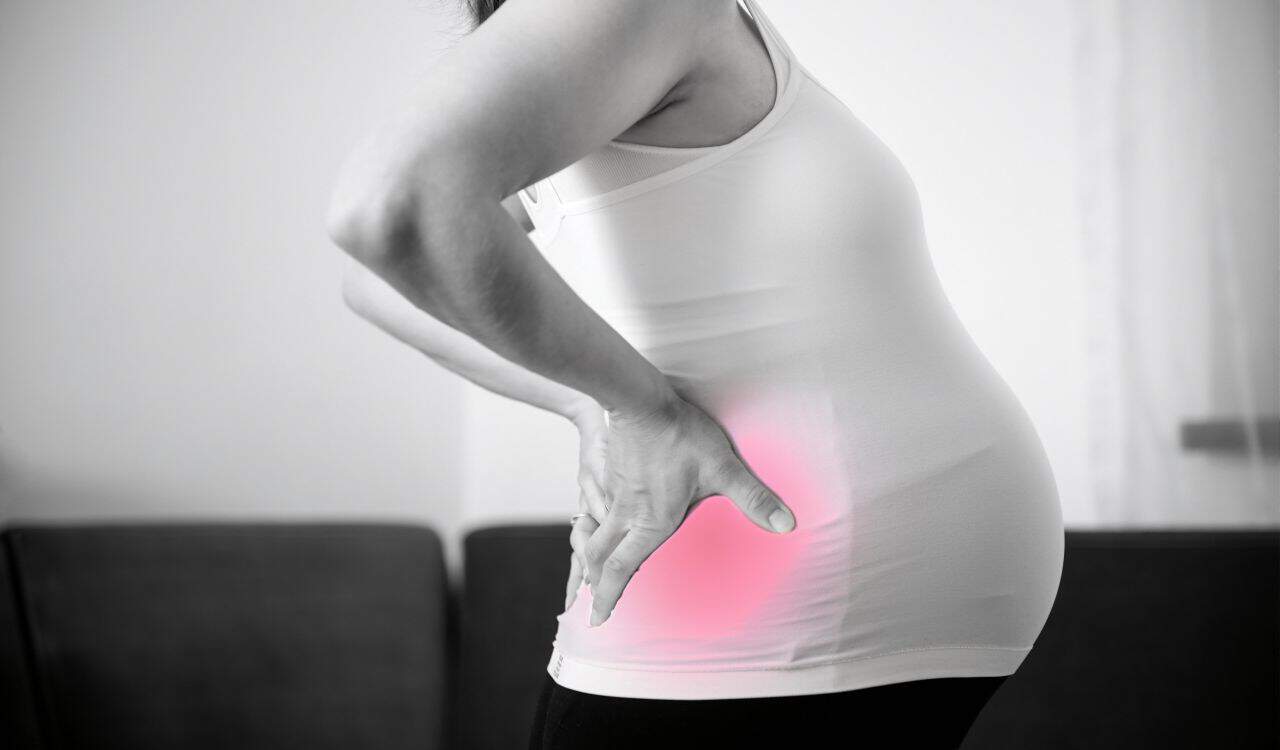
The concern arises because when inverted, significant changes in blood pressure and flow occur. Now, when a woman is carrying a baby, that fetus relies on the mother’s circulatory system. Moreover, in the final months of her pregnancy, a mother is likely to experience a slightly elevated blood pressure which is a natural response meant to produce excess blood for the baby.
And as we mentioned above, people with high blood pressure should abstain from using inversion tables as their symptoms are likely to become exacerbated.
With that being said, we would strongly recommend a pregnant woman avoid using an inversion table before consulting with her healthcare practitioner first and ensuring both her and the baby will be safe.
Inversion Table Pros and Cons
Now that we better understand the benefits and risks inversion tables present, let’s summarize key pros and cons of these tools.
Pros
- Inversion tables are among the most effective inversion tools
- Offer multiple research-backed benefits, from feeding your brain with more oxygen-rich blood to back pain relief
- Are non-invasive tools which can reduce the need for spinal surgeries
- Can be used to strengthen core muscles and improve fitness levels
- Allow you to decompress your spine without paying an expensive visit to a chiropractor
Cons
- Elevate blood pressure and alter circulation, which can be problematic for those with related pre-existing conditions
- Can cause anle discomfort in some people
- Increase chances of a pulled muscle
Other Inversion Tools to Consider
Now that you know what inversion tables are used for, you might be wondering if there are other tools fit for this purpose. True, when it comes to reversing the effects of gravity, inversion tables are without a doubt the most popular devices on the market. They’re versatile, efficient, and come in a myriad of styles, material, and finishes to match your preferences.
However, depending on your age, budget, fitness level, and experience with inversion therapy in general, you might want to give other anti-gravity tools a thought. Here are some of the most common inversion table alternatives.
Inversion Table vs Gravity Boots
For many people, gravity boots are the holy grail of inversion. It’s the efficiency and simplicity of this system that attracts enthusiasts across the globe.
However, unlike inversion tables, gravity boots only allow their users to hang upside down completely, without the ability to tilt at a desired angle.
Moreover, because of the nature of the system, it can be quite difficult to use gravity boots in the first place and the process requires a certain level of physical strength and stamina.
Inversion Table vs Anti-Gravity Chair
Now, inversion chairs are great because of their ease of use and comfort. Whereas other tools require some level of effort to mount and dismount, an anti-gravity chair is super simple to get in and out of, making them a great pick for senior citizens and those with limited mobility.
These are very similar to inversion tables. In fact, the only thing that separates one from another is the fastening mechanism, the angle of inversion, and additional features. In addition, most inversion chairs allow you to hang upside down with your knees bent, meaning the weight load is evenly distributed and doesn’t pressure your joints.
Inversion Table vs Yoga Swing
Also called yoga trapeze or yoga slings, these swings are used to achieve a variety of inverted yoga positions. We would recommend them to those looking for a more natural way of practising inversion. Apart from reaping the rewards of hanging upside down, users can also exercise with the help of the sturdy yet flexible swings.
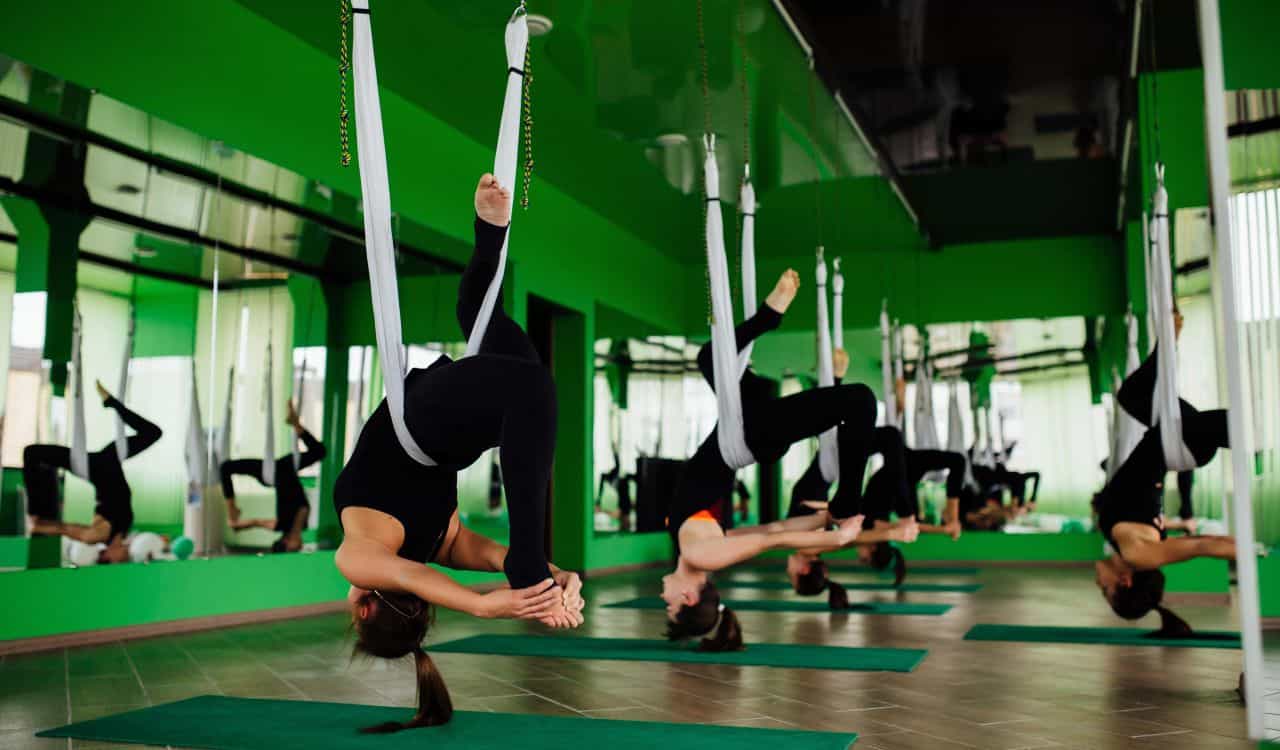
Note that, unlike inversion tables, you ought to at least be familiar with the basics of yoga besides being in decent shape to use these tools – it may look easy but the process can get quite tricky.
How to Use an Inversion Table
Using an inversion table from the comfort of your home is pretty straightforward. Simply put, you tilt yourself upside down to a preferred angle while strapped on the table. Once inverted, you can gently stretch your body and relax or even get some challenging exercises done.
Check out this instructional video that explains how to correctly and safely use an inversion table.
Still, there are a few things you ought to have in mind to prevent injuries and invert safely. It should be noted that each model will come with different settings and you should make use of the manufacturer’s manual prior to your session. With that being said, let’s get hanging.
Assembly
Before you even start assembling the unit, ensure there’s sufficient space around you. Ideally, you’re looking for an indoor spot with at least five feet of space around you. Your living room, basement, attic, or garage should do just fine. As long as you can move freely in all directions without banging on a piece of furniture or something, you’re good to go.
When you’re ready, check the assembly instructions from the manufacturer and start putting the unit together.
The correct assembly and setting up of inversion table is vital if you want to prevent injuries and invert safely.
Setting Up
After you’re finished with assembling your unit, you will need to set the inversion table to make every session as comfortable and effective as possible. There are four essential adjustments you ought to set before starting out. They include:
- The height adjustment tube
- Angle of inversion
- Ankle holders
- Additional features
Height Adjustments
Before you lay down on the table, make sure you adjust the height according to how tall you are. Once you’re done with the assembly, set your ideal height by working the height adjustment tube.
Most inversion tables come with a bar or a ratcheting system that can be easily manipulated by a twistable knob or a metal pin. Once you’ve adjusted the correct height, make sure you tightly twist the knob or place the pin back securely in place.
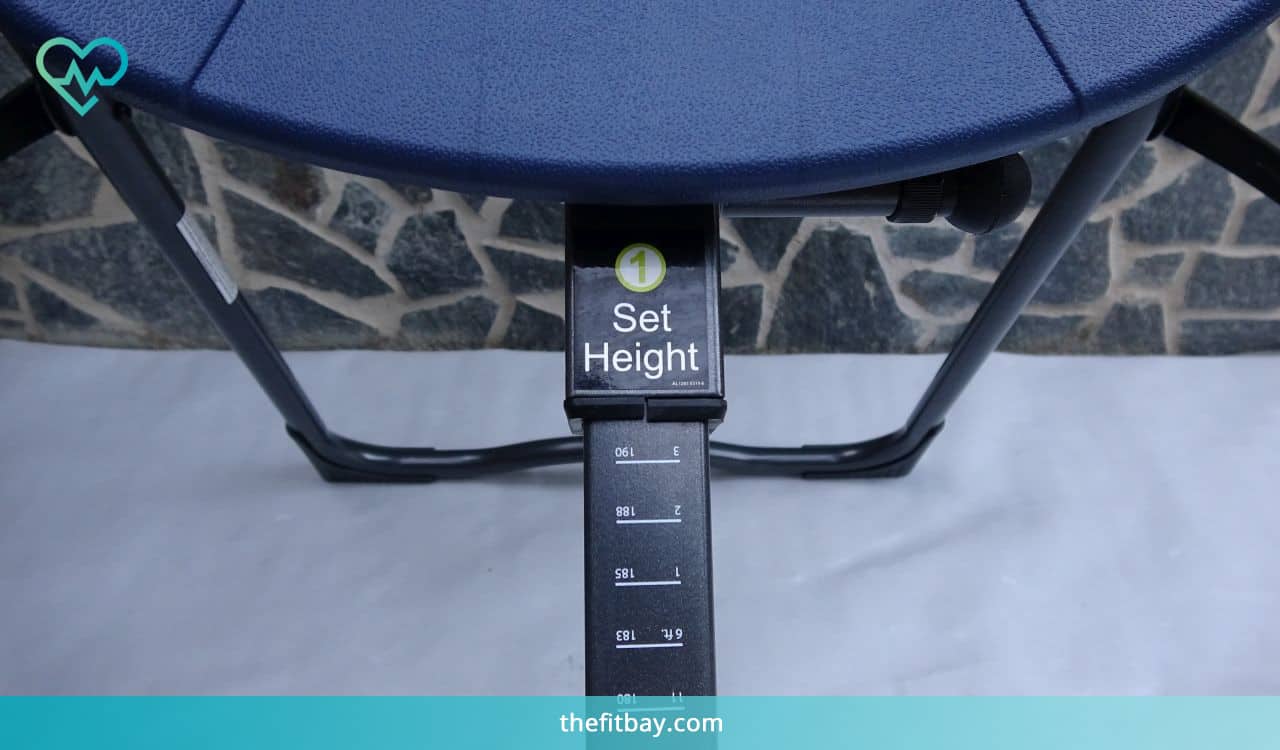
Angle of Inversion
To set an inversion angle, refer to your instructions manual. Most inversion tables, such as Teeter EP-960 (Ltd.) will have an adjustable strap that controls the angle. or a lock mechanism using a metal pin to set the preferred angle – as is the case with Innova ITX9600.
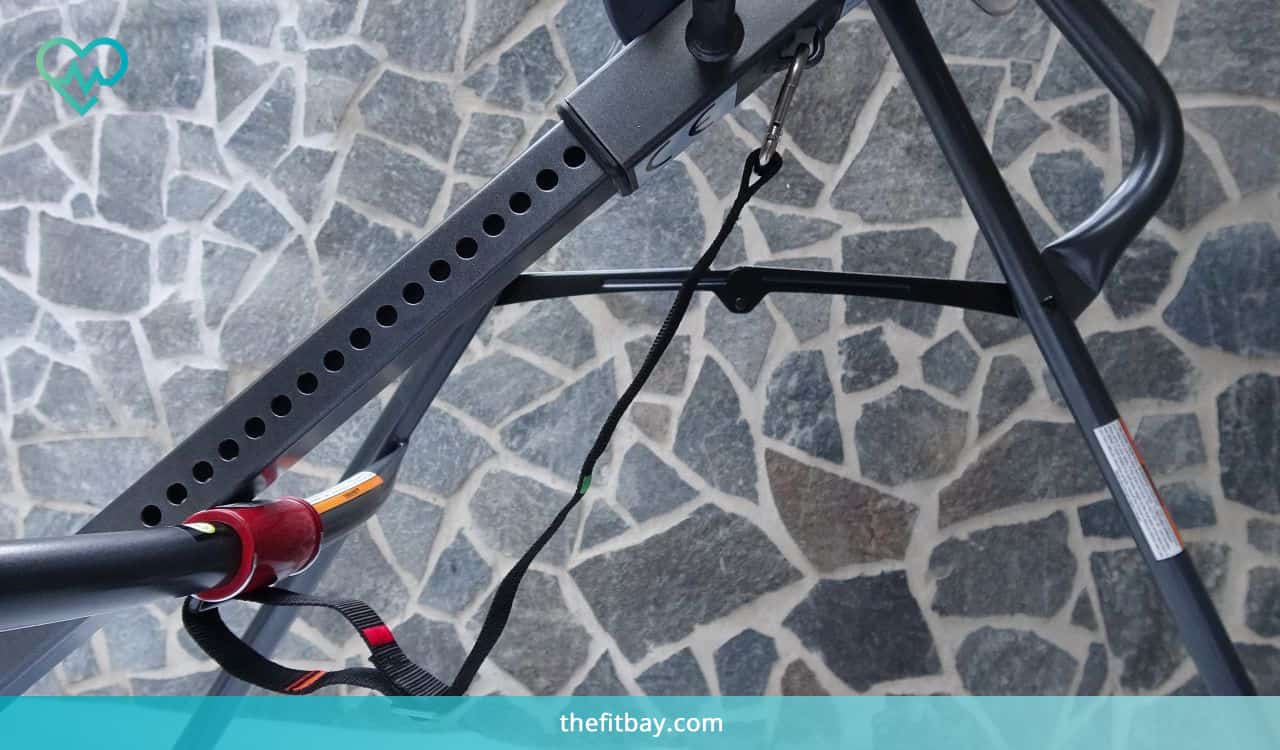
Ankle Holders
Once you’ve set your preferred height and the inversion angle, slide onto the flat board and lean down to secure your legs. Set the preferred tightness and position of your ankle holders and securely strap your legs.
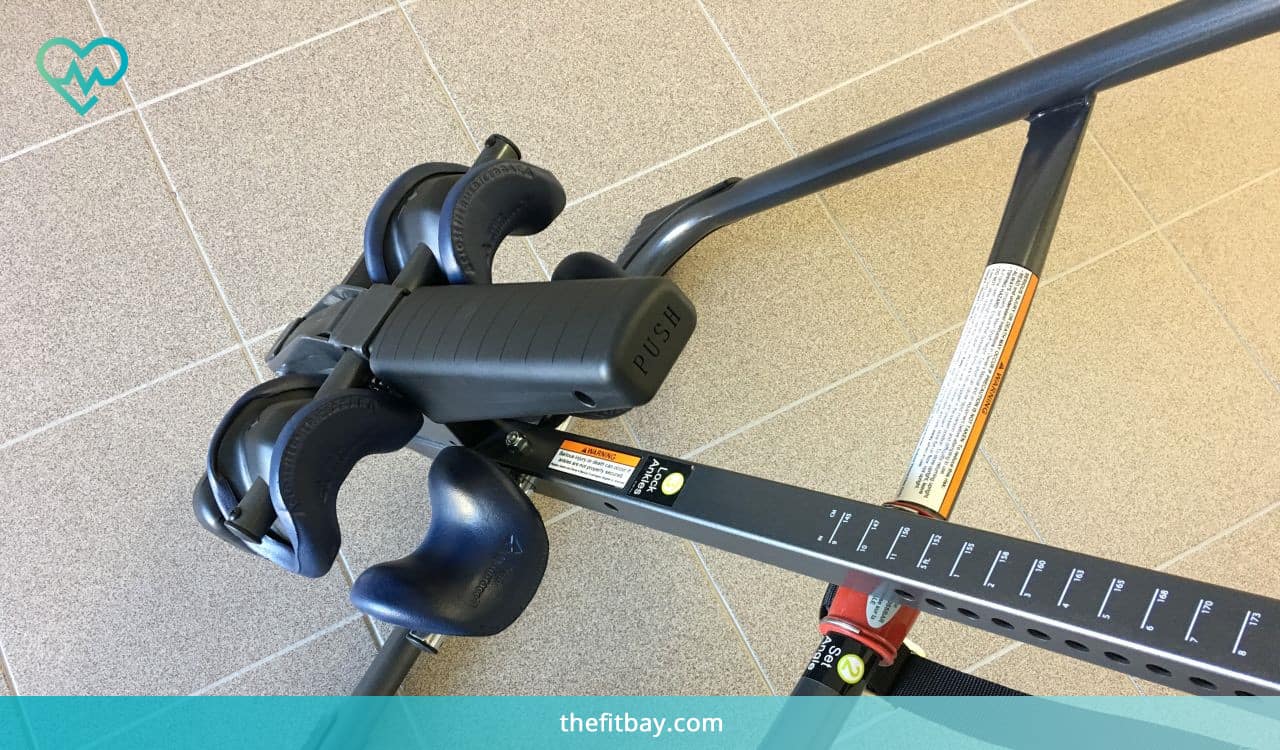
Additional Settings
If your inversion table features additional functions, such as lumbar pad, Acupressure Nodes or massage and heat options, set these the way you want or check the manual if you need extra guidance.
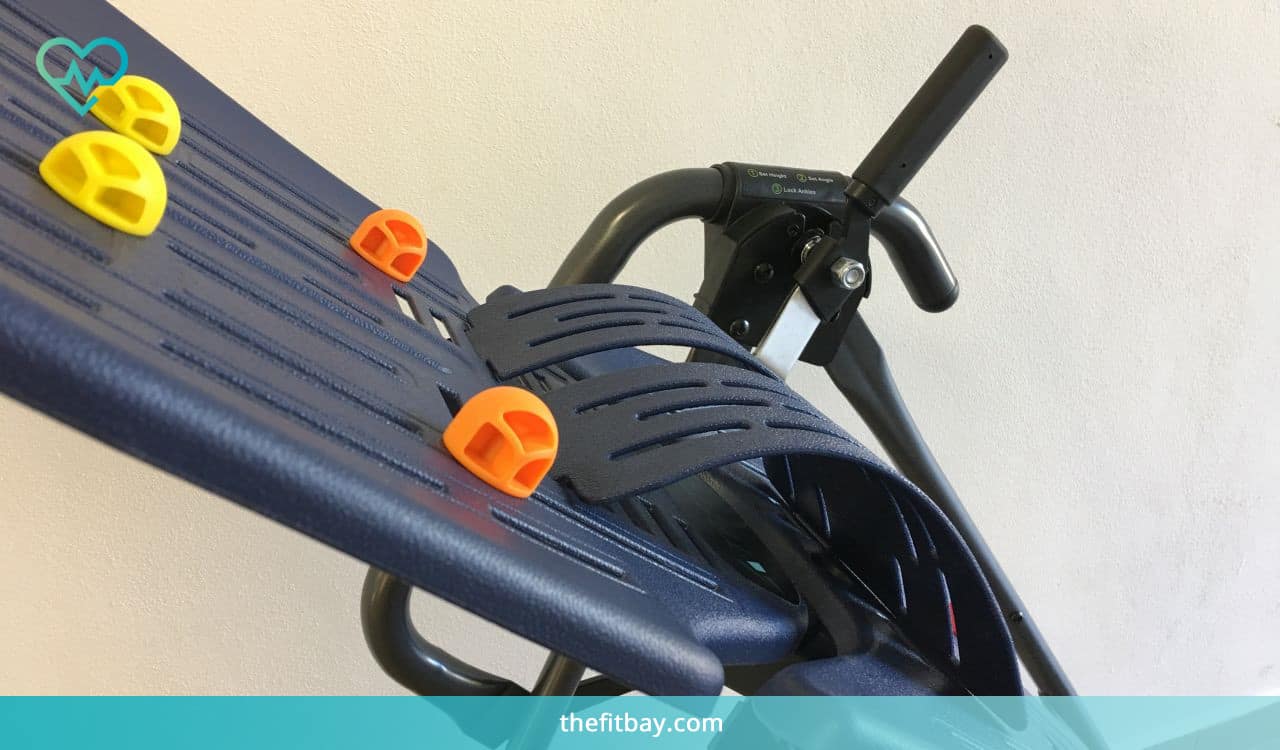
Extra tip! For added stability, consider placing a rug or mat underneath your inversion table to prevent sliding. Some models will already come with rubber floor protectors designed for this purpose.
Think About Location
Any indoor area is a suitable place for your inversion session, as long as there’s 2-3 ft of space around you. Realistically, you could practice in a smaller space but be careful not to smack your hand on the wall or a piece of furniture.
Ensure You’re Wearing the Right Clothes and Footwear
Regardless of your sex, make sure you’re wearing the correct clothes when using an inversion table.
Bare feet and jeans won’t do; instead, put on comfortable, preferably high-top sports shoes and leggings, as though you were going for a run. It should go without saying jewellery and watches are off limits.
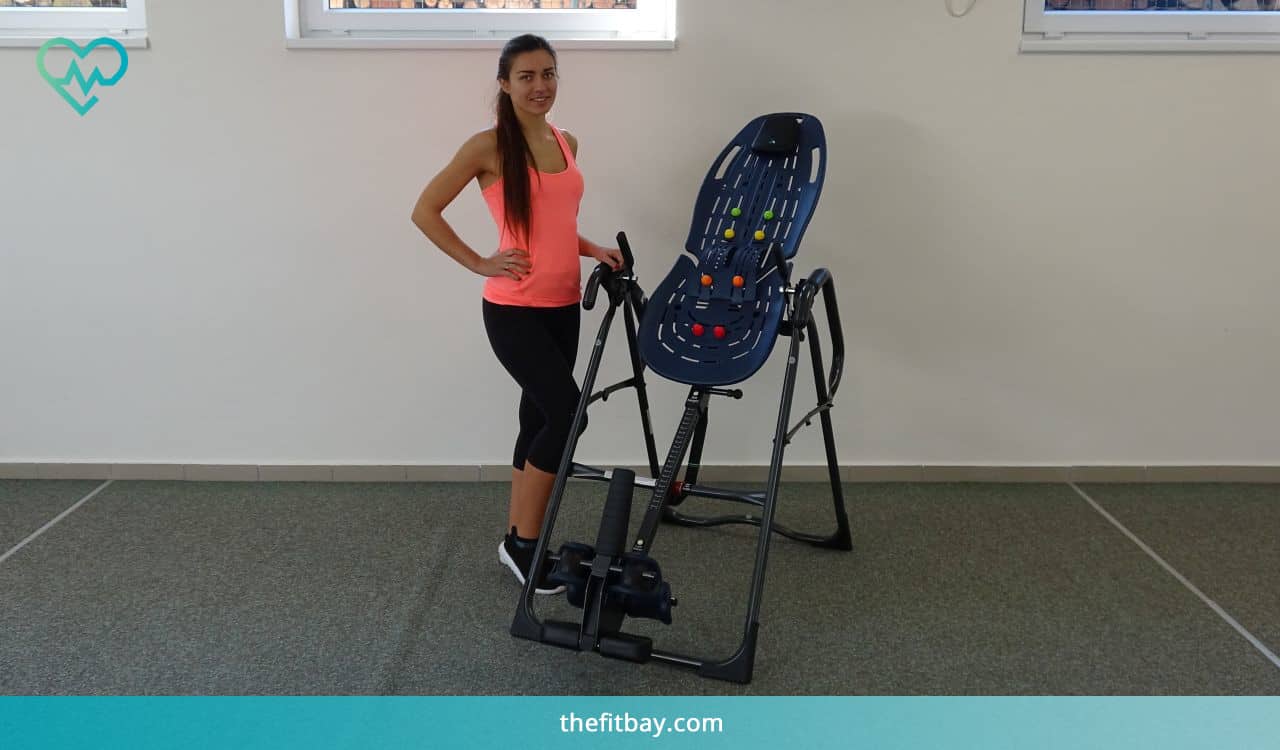
Turn Your World Upside Down
After you’re certain your feet are secured, gently lift your arms behind your head as the table begins rotating. If you’re a little scared of doing this on your own, ask a friend or family member to supervise you.
How to use an inversion table? Avoid rapid movements and hold onto the handles if there are any. Lean back until you’ve reached the preset inversion angle. Once there, breathe deeply, in through your nose, and out through the mouth. Relax. You’re giving your body some time off. Hold the position for as long as you feel comfortable.
If you’re wondering how long you should invert for, remember that complete beginners shouldn’t exceed the 5 minute limit. Advanced users can invert up to 20 minutes. As long as you feel comfortable, there shouldn’t be an issue. However, keep in mind that it’s better to invert three times per day in shorter intervals than to have a single, lengthy session.
Getting Back on Your Feet
Many people wonder if they can get going with their activities following the use of an inversion table. The answer is yes. In fact, when you feel some relief of your symptoms after using your inversion table, it is actually encouraged that you follow this up with some activity.
Whether it’s walking, bending over, or lifting objects, you should most definitely take advantage of the decreased sensitivity of your body’s nervous system following inversion therapy. There’s no need to worry about increased risks. Inversion does not cause any soft tissue or joint damage that would impede your daily activities, it actually prompts your body to get moving.
When you experience relief in your symptoms, you may find your range of motion has improved and so did the ability to perform activities that were previously more painful.
Ease into it if you haven’t performed certain strenuous movements for a while. Then, as you gradually adapt your body to moving around and being active, you will reinforce your structure that could lead to more permanent changes in symptoms. Slowly putting stress on your body allows it to adapt and shape up.
Know Your Limits
Chances are you are an inversion newbie and that’s absolutely fine. Just remember this is not a race – presetting a challenging angle of, say, 60 degrees for your first session is a major red flag. You’re likely to feel dizzy, nauseous, or disorientated right after you’re finished inverting. And then you might feel repelled from using an inversion table ever again.
To prevent this from happening, start with a modest angle. For example, 20 degrees works great for first-timers. As you feel more comfortable with the changes in blood flow and pressure, gradually work your way up to 30, 40 and then 60 degrees. Also, allow yourself some 10-30 seconds in horizontal position before fully returning to the starting position. This is to allow your body some extra time to re-adjust.
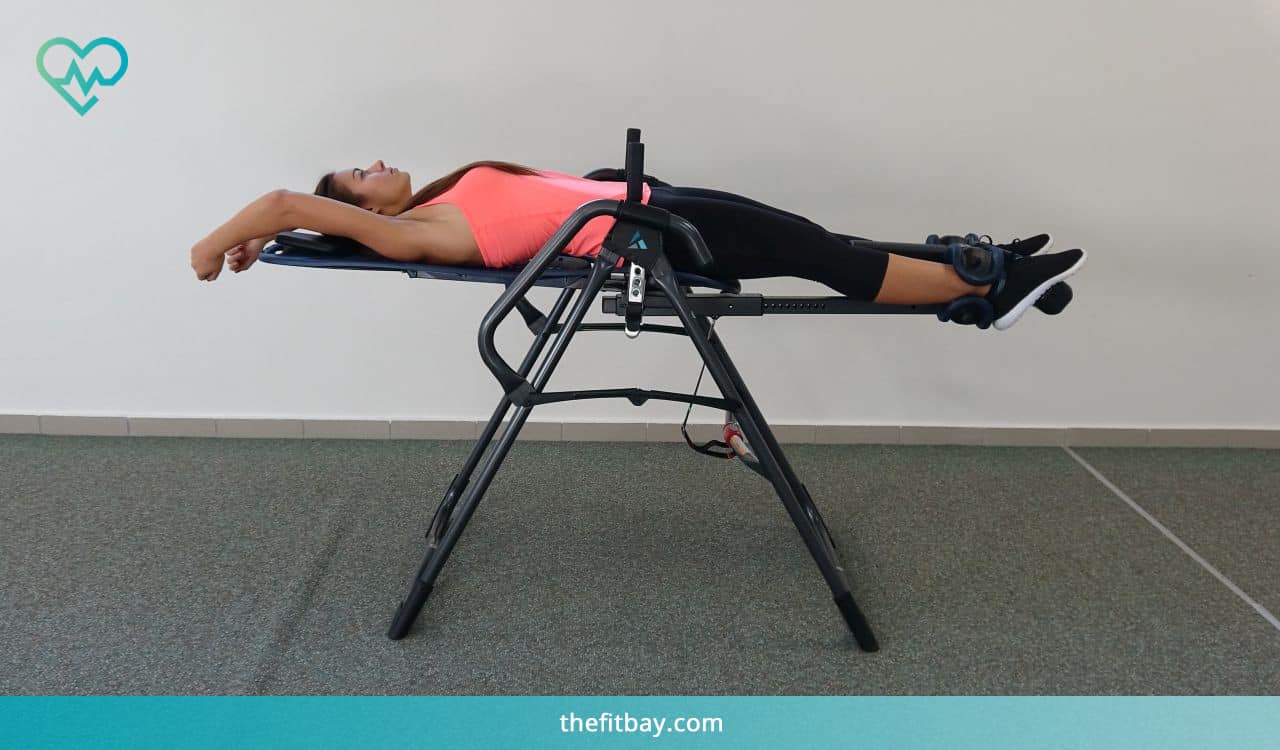
Remember that benefits of inversion start at a 20-degree angle and at 60 degrees you will feel the full benefits of inversion which we’ve discussed above.
Extra Tip! Create a routine for yourself. Put some time aside for an inversion session; hanging upside down for a few minutes in the morning will kick-start your day, and an evening session works great to relax your body before bed.
Tips for Safe and Effective Inverting
Now that you know how to properly use an inversion table, let’s summarize 10 key points you ought to keep in mind.
- 1. Prior to using one, make sure your inversion table is in a spacious area.
- 2. Configure the settings to your individual preferences.
- 3. Wear comfortable clothes and sports shoes. Remove all jewellery.
- 4. Give your body the time to adjust to an inverted position by starting out with a modest angle and gradually increasing it.
- 5. Once you’re upside-down, breathe in deeply through your nose and out your mouth, while gently stretching your arms sideways and down.
- 6. Whenever you feel discomfort, including dizziness, nausea, or lightheadedness, come back up and dismount your inversion table. Start again later with a smaller inversion angle.
- 7. Keep your initial sessions short and frequent. Frequency beats duration.
- 8. Listen to your body. How long is too long for you?
- 9. Do not invert after physical exercise. Your blood flow and pressure are skyrocketing after working out and you should steer clear of your inversion table until your body cools down.
- 10. Depending on the particular model and its ease of use, considering asking your friend, neighbor, or family member to assist and supervise you during your session.
Folding an Inversion Table
Last but not least, storing your inversion table after use is crucial. The method for doing so will very much depends on the particular model you select. Dimensions of these devices vary significantly and so do the storage requirements. Also, some, if not most of the modern inversion tables are foldable and portable. Make sure your device is folded properly and won’t unfold by mistake and cause injuries by falling onto somebody.
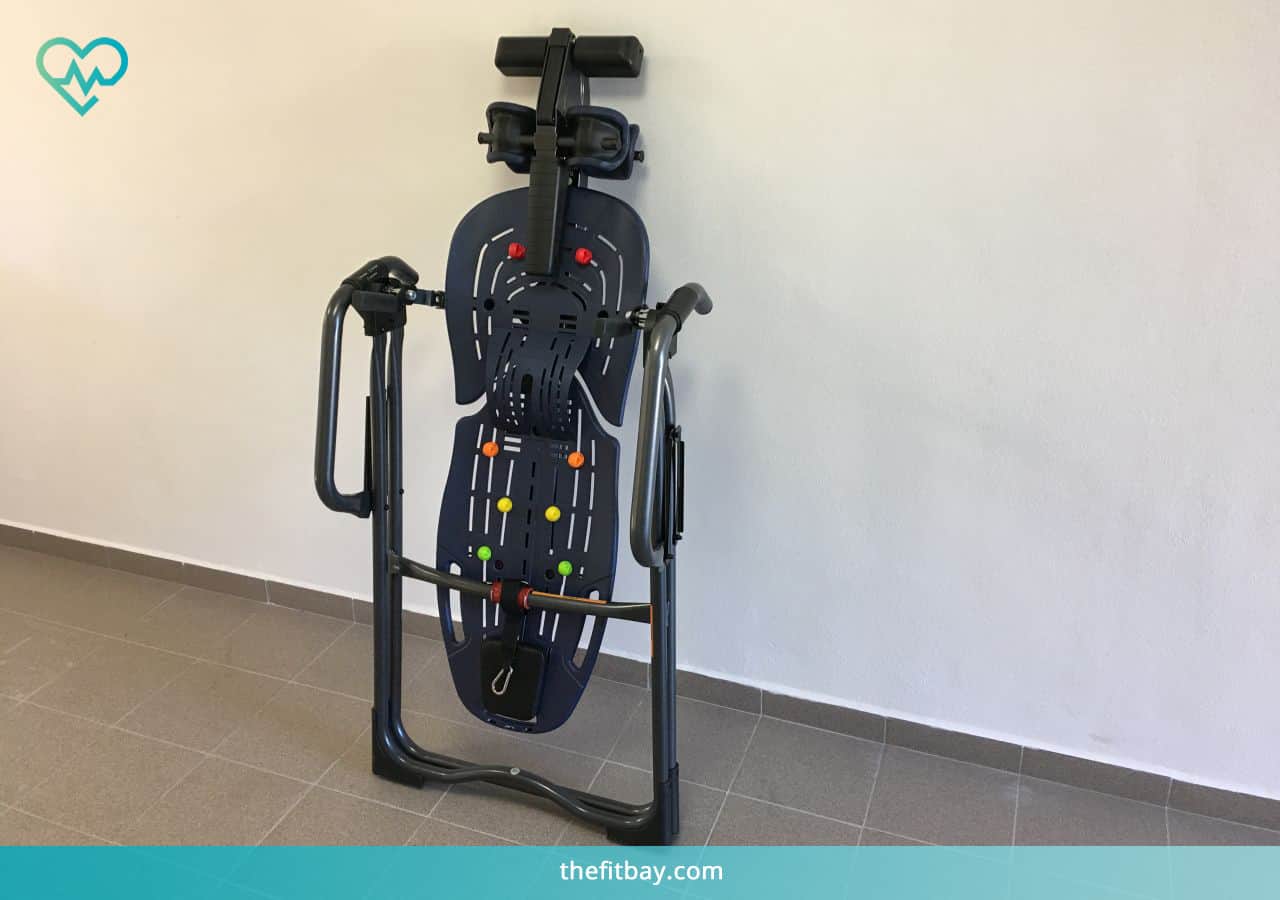
Exercising on an Inversion Table
Our course is the right place for detailed, in-depth instructions on how to exercise on an inversion table. We’ve left no stone unturned in spelling out every last aspect of inversion table use and exercise.
This includes different types of exercises, and each exercise includes recommendations for how long to conduct the exercise (minutes per session, sessions per day), which inversion angle to use for each, and thorough instructions for performing each exercise.
The course is broken down into several categories of users, from new users to advanced ones, and includes general notes and warnings for proper use and understanding of the inversion table.
Get this course and much more!
How to Find Your Perfect Inversion Table
We’ll keep this one short as we’ve already covered this topic in detail during our quest for the best inversion table out there. You should know that inversion tables, unlike other devices fit for the same purpose, are incredibly ample on the market. This means you’re likely to get lost in the sea of choice, with models featuring different functions, designs, and finishes thrown at you.
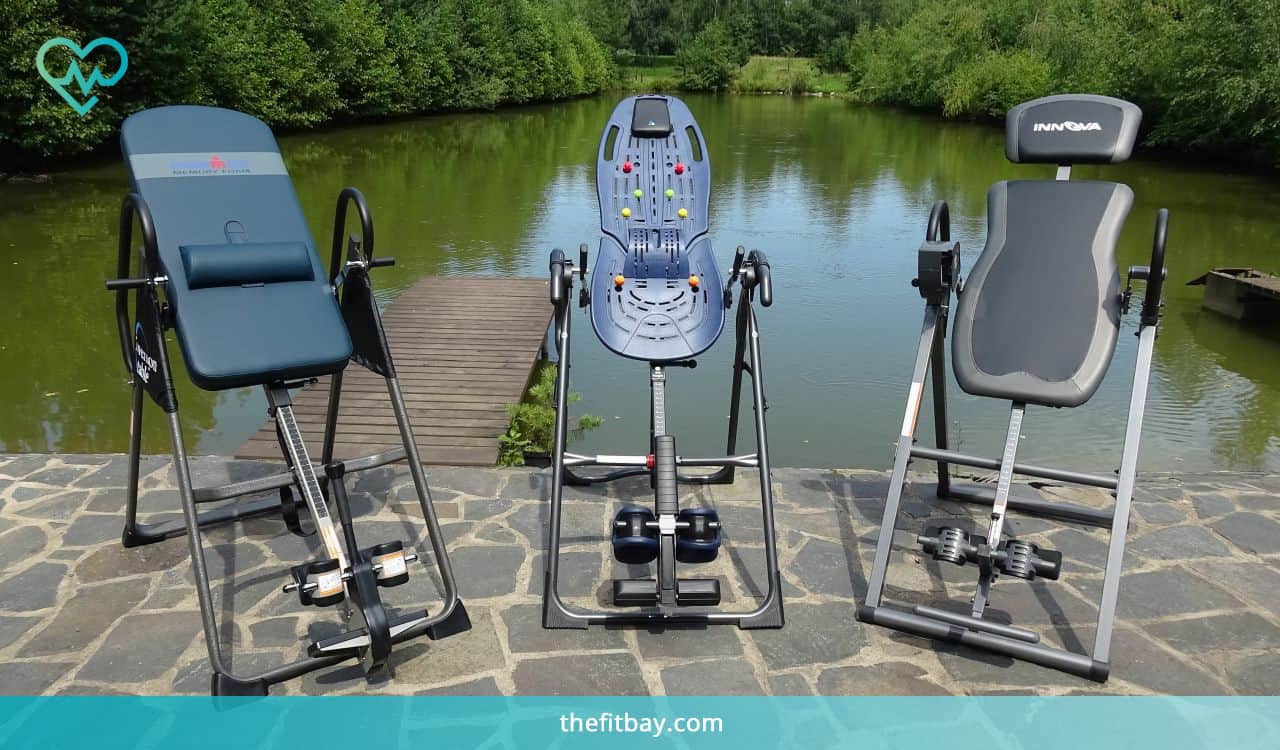
But don’t get discouraged. You ought to invest time in research if you’re concerned with your health. We’ll assume that you are; after all, that’s why you’re here. Again, we’ve done the heavy lifting bit for you and narrowed down your choice drastically in our designated post. But you’ll still need some pointers to make the final decision.
Choose a Trusted Brand
The rule of thumb is to go for the most renowned inversion table brand you can afford. The more reputable the maker is, the more reliable and efficient the device – as is with any product.
Especially if you’re dealing with back pain, don’t try to salvage a penny to compromise quality. Going for a Teeter model over an unnamed brand will prove a worthwhile decision in the long, both for your health and for your wallet.
Think About Budget
Obviously, you’ll want to stay inside your budget. In our buying guide, we’ve counted in the value for money factor. A cheaper inversion table may prompt you to make a quick purchase but make sure you’re not spending your hard-earned buck on something that’ll break down in a matter of weeks.
What Matters to You?
Is it the comfort? Functionality, perhaps? Or is it a mix of both along with storage options. Keep your preferences in mind while scouting for the best inversion table for your needs. You’re likely to use this device for a long time, which means you have to love it each time you lay on it.
FAQs
If you’re still in the fog and have an unanswered question about any aspect of the inversion tables, we’ll try to clear the mist with the answers to some of the most commonly asked questions.
Does It Take Long to Notice the Benefits?
You’re bound to feel most of the effects, such as reduced muscle tension and improved blood flow the first time you use an inversion table. Pain relief also occurs almost immediately but we recommend you stick to a regular routine to feel longer-lasting effects.
Can I Worsen my Back Pain?
As with any other fitness tool out there, incorrect usage of an inversion table can result in a sharper back pain. That’s why we’ve explained the right way of using this device above.
Is It Normal to Feel Ankle Discomfort?
Moderate ankle pain is a common side effect of using an inversion table, purely because of the system’s nature. To minimize discomfort, ensure you’re wearing comfortable shoes (preferably with padding surrounding your ankles) and that you’ve adjusted the leg-locking mechanism so that it doesn’t fit too tightly.
What’s the Greatest Misconception about Inversion Tables?
Perhaps the greatest delusion about inversion tables is the notion that you ought to hang upside down for a long time to feel the benefits of inversion. This is completely wrong. As we’ve explained before, frequency is more important than duration and keeping this rule in mind will greatly maximize the efficiency of your sessions.
Wrapping Up
If you’ve stuck with us until the end of this article, well done and thank you. You’ve now gained a new perspective on just how fascinating these therpatucial tools can be. Hopefully, you’ve also learned that approaching this device with respect and some forethought is the key to a safe and effective inversion.
Head over to our review page about best inversion tables to find a perfect pick for your needs. Hopefully, our recommendations can improve the quality of your life for many years to come.
Alternatively, we’d be happy to hear your thoughts on inversion tables and the ways in which they helped you lead a more fulfilled life. Get in touch with us via our contact page to share your experience.


